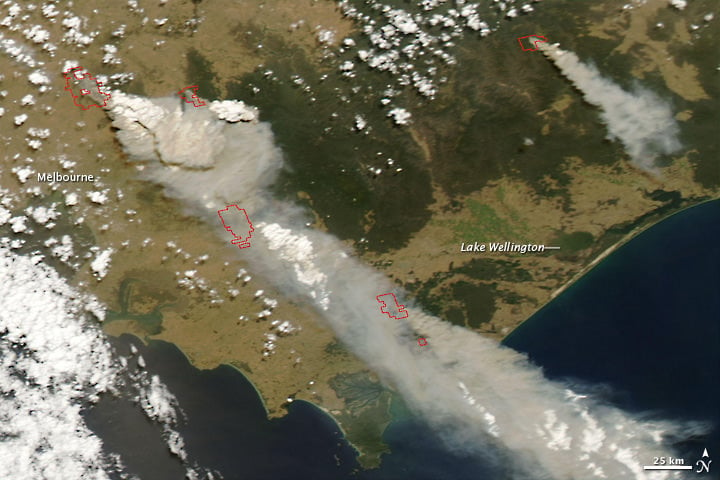[/caption]
UPDATE: Satellite Images from February 9 have now been added below.
As of this writing,
94 people
(update 2/9/09) 135 have been killed by out-of-control bushfires in southeast Australia. This image from the Moderate Resolution Imaging Spectroradiometer (MODIS) on NASA's Aqua satellite shows multiple large fires (outlined in red) burning in Victoria on February 7. Huge plumes of smoke spread southeast, driven by fierce winds.
Click here to see a larger version of the image
, which shows a larger area, and a dust storm blowing over interior deserts to the northwest. News sources report these fires sprang up and exploded in size in just a few short hours. According to
ABC News,
authorities suspect arsonists are responsible for some of the fires. NASA says images captured by another satellite, the Terra MODIS sensor, just a few hours prior to this image showed no sign of these fires. Twice-daily images of southeastern Australia are available from the MODIS Rapid Response Team, and Universe Today will try to update the images when they are available. See more below.
[caption id="attachment_25002" align="aligncenter" width="580" caption="Satellite image aquired Feb. 9 of southeastern Australia bushfires. NASA image courtesy the MODIS Rapid Response Team, GSFC. "]
[/caption] The bushfire pictures above and below shows the Barry Mountains of central Victoria on February 9, 2009. The image at top is a natural-color (photo-like) view captured by the Moderate Resolution Imaging Spectroradiometer (MODIS) on NASA's Aqua satellite. Places where the sensor detected active fire are outlined in red. The image below is the same scene shown in false color, using visible, near-infrared, and shortwave infrared light. Burned areas are brick red, and places of intense heat—often a sign of open flame in this kind of image—are glowing pink. Smoke turns a transparent blue, which makes it easier to see the ground. [caption id="attachment_25003" align="aligncenter" width="580" caption="False color image acquired Feb. 9. NASA image courtesy the MODIS Rapid Response Team, GSFC"]
[/caption] Southeast Australia has a history of severe fire problems, with some historic deadly fires such as Ash Wednesday of 1983, and lesser fires almost every year. The state of Victoria averages about 19 large fires (over 1,000 hectares) per year, but the fires this year are considered to be the worst ever. These fires are often fast like grassfire but more intense. 700 homes have been destroyed, and it is feared the death toll will rise to over 100. Twenty-six fires continue to burn across Victoria; 12 of those are out of control. [caption id="attachment_24870" align="aligncenter" width="580" caption="Satellite image of Australian bushfires from January 30, 2009. NASA image created by Jeff Schmaltz, MODIS Rapid Response Team, Goddard Space Flight Center. "]
[/caption] This image was taken on January 30, during the beginning of when some of the fires began to break out. A crippling heat wave and strong winds contributed to an outbreak of forest and grassland fires in Victoria.
Sources:
NASA Earth Observatory
,
ABC News
 Universe Today
Universe Today
